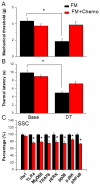Electroacupuncture Reduces Fibromyalgia Pain via Neuronal/Microglial Inactivation and Toll-like Receptor 4 in the Mouse Brain: Precise Interpretation of Chemogenetics
- PMID: 38397989
- PMCID: PMC10886830
- DOI: 10.3390/biomedicines12020387
Electroacupuncture Reduces Fibromyalgia Pain via Neuronal/Microglial Inactivation and Toll-like Receptor 4 in the Mouse Brain: Precise Interpretation of Chemogenetics
Abstract
Fibromyalgia (FM) is a complex, chronic, widespread pain syndrome that can cause significant health and economic burden. Emerging evidence has shown that neuroinflammation is an underlying pathological mechanism in FM. Toll-like receptors (TLRs) are key mediators of the immune system. TLR4 is expressed primarily in microglia and regulates downstream signaling pathways, such as MyD88/NF-κB and TRIF/IRF3. It remains unknown whether electroacupuncture (EA) has therapeutic benefit in attenuating FM pain and what role the TLR4 pathway may play in this effect. We compared EA with sham EA to eliminate the placebo effect due to acupuncture. We demonstrated that intermittent cold stress significantly induced an increase in mechanical and thermal FM pain in mice (mechanical: 2.48 ± 0.53 g; thermal: 5.64 ± 0.32 s). EA but not sham EA has an analgesic effect on FM mice. TLR4 and inflammatory mediator-related molecules were increased in the thalamus, medial prefrontal cortex, somatosensory cortex (SSC), and amygdala of FM mice, indicating neuroinflammation and microglial activation. These molecules were reduced by EA but not sham EA. Furthermore, a new chemogenetics method was used to precisely inhibit SSC activity that displayed an anti-nociceptive effect through the TLR4 pathway. Our results imply that the analgesic effect of EA is associated with TLR4 downregulation. We provide novel evidence that EA modulates the TLR4 signaling pathway, revealing potential therapeutic targets for FM pain.
Keywords: TLR4; chemogenetics; electroacupuncture; fibromyalgia; microglia; thalamus.
Conflict of interest statement
There are no financial or other relationships that might lead to conflicts of interest for all authors.
Figures







Similar articles
-
Electroacupuncture Reduced Fibromyalgia-Pain-like Behavior through Inactivating Transient Receptor Potential V1 and Interleukin-17 in Intermittent Cold Stress Mice Model.Brain Sci. 2024 Aug 28;14(9):869. doi: 10.3390/brainsci14090869. Brain Sci. 2024. PMID: 39335365 Free PMC article.
-
Electroacupuncture Attenuates Fibromyalgia Pain via Toll-like Receptor 4 in the Mouse Brain.Life (Basel). 2023 May 11;13(5):1160. doi: 10.3390/life13051160. Life (Basel). 2023. PMID: 37240805 Free PMC article.
-
Electroacupuncture Mitigates TRPV1 Overexpression in the Central Nervous System Associated with Fibromyalgia in Mice.Life (Basel). 2024 Dec 4;14(12):1605. doi: 10.3390/life14121605. Life (Basel). 2024. PMID: 39768313 Free PMC article.
-
[The modulation of cerebral cortex and subcortical nuclei on NRM and their role in acupuncture analgesia].Zhen Ci Yan Jiu. 1996;21(1):4-11. Zhen Ci Yan Jiu. 1996. PMID: 9387347 Review. Chinese.
-
Electroacupuncture suppresses glucose metabolism and GLUT-3 expression in medial prefrontal cortical in rats with neuropathic pain.Biol Res. 2021 Aug 6;54(1):24. doi: 10.1186/s40659-021-00348-0. Biol Res. 2021. PMID: 34362470 Free PMC article. Review.
Cited by
-
Electroacupuncture Reduced Fibromyalgia-Pain-like Behavior through Inactivating Transient Receptor Potential V1 and Interleukin-17 in Intermittent Cold Stress Mice Model.Brain Sci. 2024 Aug 28;14(9):869. doi: 10.3390/brainsci14090869. Brain Sci. 2024. PMID: 39335365 Free PMC article.
-
An in-depth investigation of NAs-induced osteoporosis adverse events: a real-world, network toxicology and molecular docking analysis.Front Med (Lausanne). 2025 Jul 4;12:1605024. doi: 10.3389/fmed.2025.1605024. eCollection 2025. Front Med (Lausanne). 2025. PMID: 40687725 Free PMC article.
References
Grants and funding
LinkOut - more resources
Full Text Sources

